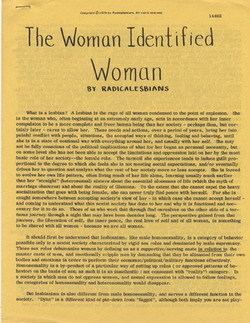 | ||
Similar Compulsory Heterosexuality and Lesbi, Lesbian Nation, Tales of the Lavender Menace, Sappho was a right‑on w, The Straight Mind and | ||
"The Woman-Identified Woman" was a ten-paragraph manifesto, written by the Radicalesbians in 1970. It was first distributed during the "Lavender Menace" protest at the Second Congress to Unite Women, on May 1, 1970 in New York City. It is now considered a turning point in the history of radical feminism, and one of the founding documents of lesbian feminism.
Contents
It was written collectively by a group including Artemis March, Lois Hart, Rita Mae Brown, Ellen Shumsky, Cynthia Funk, and Barbara XX. It was edited by Artemis March. A group of lesbian radical feminists staged a "zap" for the opening session of the Congress, during which they cut the lights, took over the stage and the microphone, and explained how angry they were about the exclusion of lesbian speakers from the Congress. They passed out mimeographed copies of "The Woman-Identified Woman," in which they argued that lesbians were at the forefront of the struggle for women's liberation, because their identification with other women defied traditional definitions of women's identity in terms of male sexual partners, and expressed "the primacy of women relating to women, of women creating a new consciousness of and with each other which is at the heart of women's liberation, and the basis for the cultural revolution." Thus, support for lesbians and an open commitment to lesbian liberation was argued to be "absolutely essential to the success and fulfillment of the women's liberation movement." A key point of manifesto is the concept that in order to elevate women from second class position, women should be willing to consider other women as sexual partners. "Until women see in each other the possibility of a primal commitment which includes sexual love, they will be denying themselves the love and value they readily accord to men, thus affirming their second-class status."
Political implications
The manifesto shrewdly observed and criticized the potentially regressive nature of the Feminist movements in the 1970s, namely omitting and neglecting the significance of lesbian voices, and the importance of incorporating lesbianism ideals in conjunction with the traditional and foundational feminist ideologies in the construction of feminist movements and feminism developments.
Furthermore, this piece of writing presented a watershed during the Second wave of feminism, while the primary focus of this wave of movements was the gender inequality in law and culture, the Radicalesbians argued that, the mere opposition to the omnipresent patriarchy in American society through the traditional feminine point of view, and the refusal to adapt and cope with traditional gender roles, are simply ineffective and inefficient to the triumph of feminism. The sheer dominance of patriarchy and the subsequent byproduct, the subliminally implemented androcentric and masculine as normality culture, will not truthfully respect and engineer significant social-cultural changes in accordance with feminist ideologies.
The manifesto points out that, although minor changes had occurred in the American society for women, such as improvements in legal rights, these changes are superficial, nominal displays presented to cope with the rising of feminism, and the realistic situation, the oppression of women embedded within the essentially patriarchal American society, the status quo of second-class, even inferior citizens for women, remains unchanged. The overt political actions of “liberating women” were overshadowed by the covertly oppressive civil actions of men. Feminism is gradually being accepted and recognized by the male dominant privileged ruling class, however, acceptance does not equal respect. The changes that occurred due to feminism were not genuine reforms or revolutions, but rather reluctant permissions, granted by men to comfort women, to ease the subversive feminist movements which challenge and threaten their legitimacy and consolidation to rule, and to rule over women.
Therefore, the manifesto served not only as a declaration, but also as a critique. It did question the validity of the core ideals of feminism and feminist movements, but alerted feminists that passive feminine argumentation that derives and delivered from heterosexual women to men, will not result in significant changes for women, while these changes are meaningful, they cannot directly threaten the male supremacy, which is the root of all oppression toward women.
Whilst, the manifesto established the foundation for lesbians in politics, especially within the realm of feminists, it triggered a ripple effect that lead to the emergence of lesbianism literature among feminist writings, and further shaped many more radical and controversial theories.
“The Woman Identified Woman” truly was a monumental argument, which further enhanced and enriched feminist movements during the Second wave of feminism. At its published time in the 1970s, it was seen as the pioneer of lesbianism advocates in feminist political theories, and in politics, its legacy carried on until nowadays.
